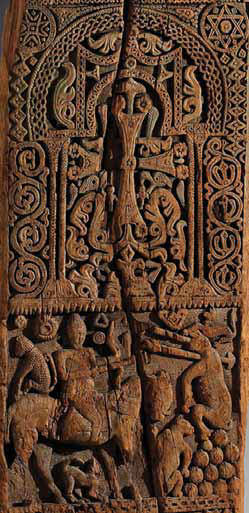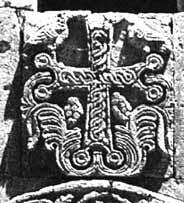Shop Amazon - Create an Amazon Baby Registry

Try Amazon Audible Plus
Detail of Armenian wooden door with cross and stylized wings,
and a royal hunt scene with a leopard behind the king,
probably from Cilicia, 12th or 13th century.

A larger image of this Armenian wooden door with cross and stylized wings, and a royal hunt scene with a leopard behind the king, probably from Cilicia, 12th or 13th century.
Fig. 167b - Détail de la porte arménienne, en bois sculpté d’une croix et d’ailes stylisées, ainsi que d’une scène de chasse royale, un léopard se tenant derrière le roi (XIIe siècles)
Fig. 167b - Detail of Armenian wooden door with cross and stylized wings, and a royal hunt scene with a leopard behind the king (12th century)
More to the point is the integration of the pair of wings into the Christian iconography of Armenia, the first state—before Rome—to officially embrace Christianity.
The Armenians depict their Holy Cross with a pair of stylized wings underneath (fig. 163) and refer to it as
P`ark` Khch` (“Glorious Cross”). Because p`ark` is the Armenian equivalent of the Persian Farr and derives from a common root,216
we can only conclude that the wings were added to the cross as a substitute for the word Glorious.217
Since the Armenian kingdom was an offshoot of the Parthian’s, its regal iconography generally mirrored the Persian one.
Thus, in a 12th century wooden door from the Armenian kingdom of Cilicia (fig. 167b),
we not only see the Cross with its pair of stylized winged underneath but also a hunting scene in which the king,
as in Sasanian rock reliefs and silver plates (figs. 157, 166), is confronting a ferocious animal (a bear in this case) depicted twice: initially alive and then shot at.
Moreover, on the back of the king’s horse sits a leopard.
The leopard as well as the falcon were prized accessories of royal hunts in the Eastern kingdoms (e.g., fig. 167a) and, therefore, symbolized regal status.
216 The Armenian language is from the family of Indo-Iranian languages.
217 Soudavar 2003, pp. 22-23.
 Fig. 157 Chosroes II hunting, rock-relief at Taq-Bostan, Iran, 7th century, (Photo by A. Soudavar)
Fig. 157 Chosroes II hunting, rock-relief at Taq-Bostan, Iran, 7th century, (Photo by A. Soudavar)
Fig. 163 Armenian cross with stylized wings, from the Church of the Holy Cross. Aght`amar, Turkey.
Fig. 166 Plate with king hunting rams, Sasanian period; A.D. 5th–6th century, Iran, Metropolitan Museum of Art, New York, Fletcher Fund, 1934 (34.33). [The plate depicted is actually the Sari Plate, A Sasanian Noble Hunting Lions, from Iran, Tehran - Iran Bastan Museum 1275]
Fig. 167a Akbar hunting a black buck with a leopard, detail of a page from the 1590-95 Akbarnama manuscript, Victoria Albert Museum, London, IS 2 92 1896 (Photo by A. Soudavar)
Fig. 167b Detail of Armenian wooden door, probably from Cilicia, 13th century, Courtesy of Sam Fogg, London.
Source: pp. 115-116, Decoding Old Masters Patrons, Princes and Enigmatic Paintings of the 15th Century by Abolala Soudavar
See also Warrior Saints on the North-West Facade, Surb Khach Church, Armenian Church of the Holy Cross, Akdamar Island, Van Province, Turkey
"Roslin" Four Gospels, 1262 AD, Armenian Cilicia, Walters Art Gallery, Ms. W. 538, Baltimore
Other 12th century Illustrations of Costume and Soldiers
For leopards on the rump of a horse see: Bowl with horseman with Leopard, 9th Century, Nishapur, Iran, National Museum of Iran, Tehran
and Nishapur Plate, MNAO, Rome, 10th century, with 3 riders with leopards on the horse's rump.


 Fig. 157 Chosroes II hunting, rock-relief at Taq-Bostan, Iran, 7th century, (Photo by A. Soudavar)
Fig. 157 Chosroes II hunting, rock-relief at Taq-Bostan, Iran, 7th century, (Photo by A. Soudavar)